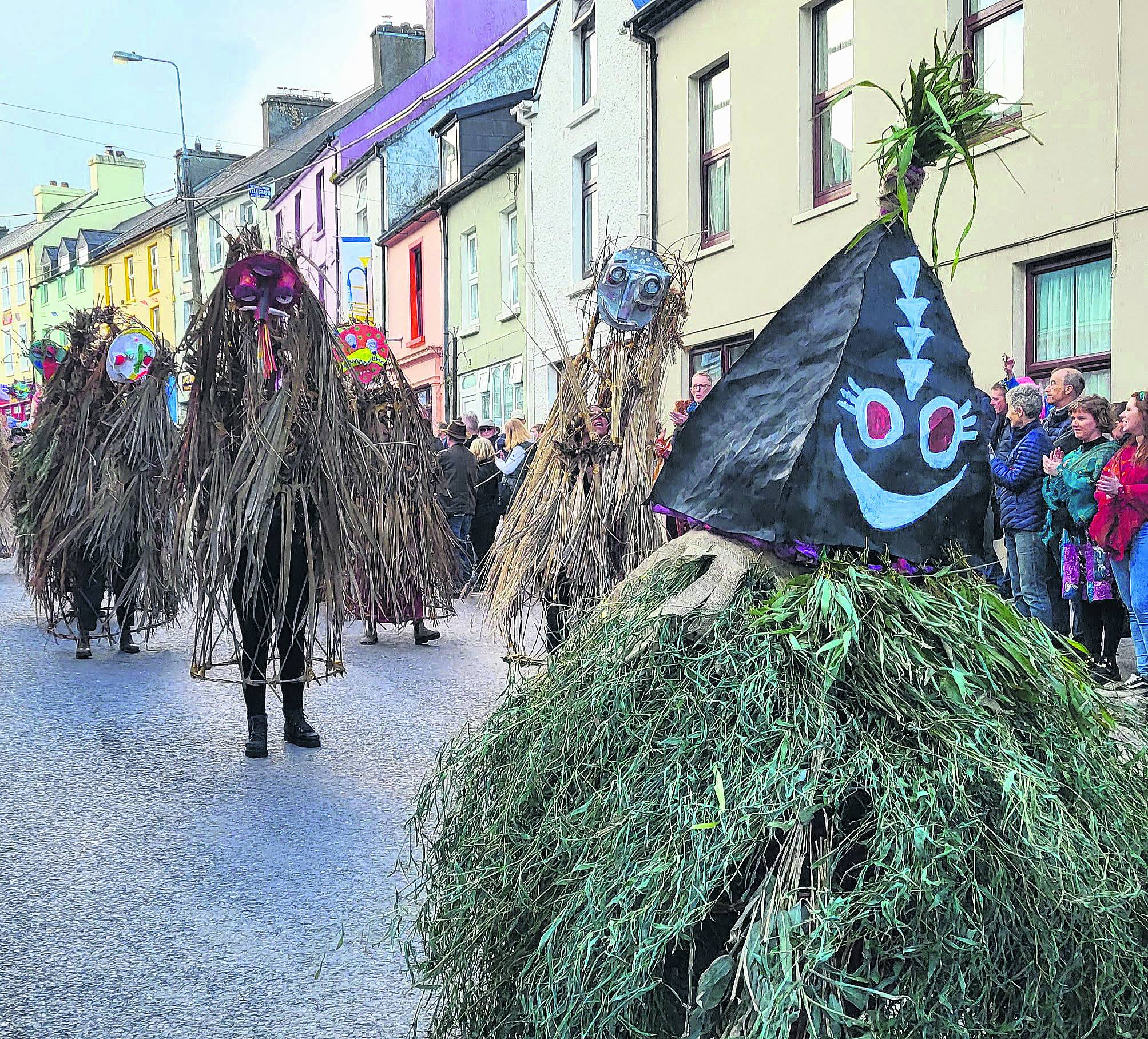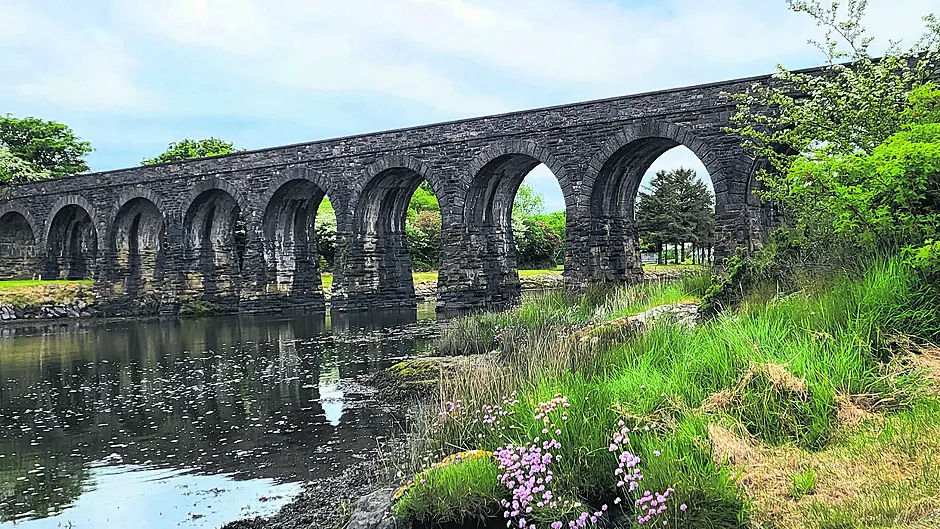From ‘Plastic Free July’ to using beach debris to make festival decorations, the diverse community of Ballydehob has a common goal of protecting the local environment and educating future generations about its importance
BY SARAH CANTY
BALLYDEHOB enjoys a respected reputation for its lively community spirit evidenced mostly by its busy festival season. Like its festivals, Ballydehob’s approach to climate action is tackled by different groups with differing ideas and a common goal.
Some groups have formed specifically with the future of their environment in mind.
Ballydonut, for example, is a locally-based organisation inspired by doughnut economics, a system aimed at balancing human needs with the planet’s finite resources.
They meet monthly to brainstorm on ways they can help make positive changes in areas of local food production, rural transport, sustainable energy and is behind an exciting biodiversity project coming soon to the estuary that flows under Ballydehob’s famed 12-arch bridge.
With the help of the environmental NGO, Cork Nature Network, and with funding from the Community Foundation for Ireland, Ballydonut have commissioned an ecologist to map habitats, surveys and assess the biodiversity, identify important species and threats to them, and make recommendations that will help inform the Ballydehob Biodiversity Action Plan.
This plan will identify priorities for conservation, achievable targets, and a list of agreed actions to meet those targets.
When complete, Ballydonut members will organise volunteers to carry out the agreed actions, step by step.
According to spokesperson Moze Jacobs, the plan will also take on board various habitats in the village and surroundings, inviting residents to take a closer look at the wonderful biodiversity that can be found not just on the land but also in gardens and public places.
 Dick Miles who runs the Fastnet Maritime and Folk Festival in June has included in his programme a Ballydonut-sponsored informational walk entitled, ‘History meets Biodiversity around the Estuary.’
Dick Miles who runs the Fastnet Maritime and Folk Festival in June has included in his programme a Ballydonut-sponsored informational walk entitled, ‘History meets Biodiversity around the Estuary.’
Ballydehob Tidy Towns, who are encouraged and rewarded for taking climate action in their work, will partner with Ballydonut on this project.
They are also planning ‘Plastic Free July’ events to help inform their community of the damage disposable plastics do to human health, to wildlife, and to nature.
Recently they were granted membership in the Sustainable Energy Community SEC. ‘We inform the public about energy audits as well as SEAI grants for energetic renovations of buildings, so that the real estates can become more energy efficient,’ explains spokesperson Peter Hermle.
Many local businesspeople incorporate good practices into their ordinary lives and ventures to meet today’s environmental challenges.
Artist Sonia Caldwell of Kilcoe Studios, for example, has always focused on nature as subject and material.
Her popular watercolour paintings of local wildflowers can be bought as greeting cards and calendars online or at local shops, including her own premises on Main Street in Ballydehob.
‘If it is about anything here in this shop it is about using local materials. Go back a hundred years and people were making things out of straw and hay and rushes … materials that grow here in absolute abundance,’ says Caldwell, who runs numerous workshops during the year, in her shop and in schools, to teach folks to make baskets, mats and other household items.
‘Many of these objects don’t last years but they are biodegradable so can be composted and new ones made every couple of years as needed,’ she explained.
Local event organisers are also conscious of climate change and do what they can to share information and lower their waste output.
For instance, Dick Miles who runs the Fastnet Maritime and Folk Festival in June has included in his programme a Ballydonut-sponsored informational walk entitled, ‘History meets Biodiversity around the Estuary,’ with historians Cormac Levis and Eugene McSweeney and ecologist Mark Robins.
The Jazz Festival is phasing in a reusable pint glass system to save on waste, and last year they used the ropes and nets and other debris found during organised beach clean-ups to make festival decorations.
‘The mission of the festival has always been to reuse, recycle and minimise waste,’ says Jazz Festival organiser Caroline O’Donnell. Other proposals to feature in next year’s festival will include increased waste facilities, incentives for customers to travel to the festival together or use public transport.
 The Willow Beasts in the recent Jazz Festival were made by members of the community at workshops run by Millie Egan in Levis’ Corner Bar and are mostly compostable. Each beast was a group effort, made from willow, other plant materials, cardboard, papier mâché and re-used paint.
The Willow Beasts in the recent Jazz Festival were made by members of the community at workshops run by Millie Egan in Levis’ Corner Bar and are mostly compostable. Each beast was a group effort, made from willow, other plant materials, cardboard, papier mâché and re-used paint.
Visual artist Millie Egan who was the lead artist in charge of jazz decorations and the jazz parade plans her work around the inevitability of cleaning up afterward.
‘It’s on my mind all of the time. Working at festivals you just see a constant relentless production of waste. And when you’re building temporary worlds, the stuff has to go somewhere, whether it is to be used again or as waste.’
The willow beasts seen in this year’s jazz parade were made of compostable materials. The willow was left over from a basket maker who couldn’t use the lower quality twigs for what he was making.
Even the bunting and the large puppet, co-created with the legendary puppet master Dr Dink, were made with re-purposed materials from previous projects.
The people who reside in Ballydehob are made up of locals and blow-ins, farmers and artists, businesspeople and musicians.
Together they always end up finding ways, sometimes many different ways, to reach their common goals.










